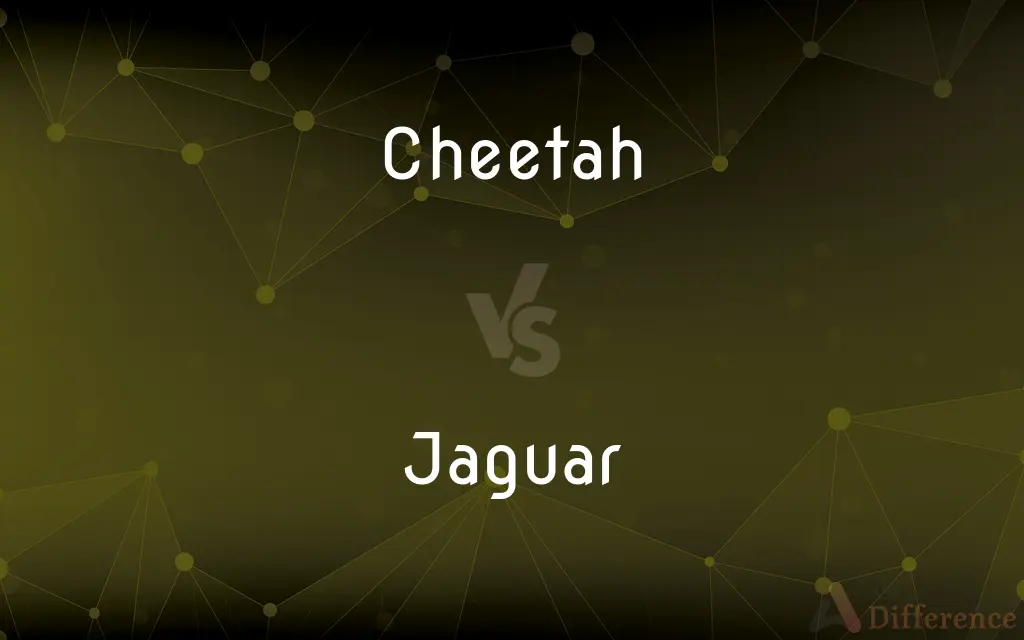Cheetah vs. Jaguar — What's the Difference?
By Tayyaba Rehman — Updated on October 13, 2023
A cheetah is a slender, fast-running wild cat, while a jaguar is a sturdy big cat with a strong build, known for its rosette spots.

Difference Between Cheetah and Jaguar
Table of Contents
ADVERTISEMENT
Key Differences
Cheetahs, known for their agility and speed, are distinctively recognized by their slender bodies and long legs. They have tear marks running from the inner corners of their eyes down to the sides of their mouth, a feature that helps focus better on prey and reduce the sun's glare. Jaguars, conversely, are powerful felines native to the Americas, notably the Amazon rainforest. They have a robust build, with shorter legs compared to a cheetah and a head that appears larger in proportion to their body.
The cheetah is famously known as the fastest land animal, capable of reaching speeds up to 58-64 mph in short bursts covering distances up to 1,500 ft. They use their speed to chase down prey in open plains. Jaguars, on the other hand, are not built for such speeds. Instead, they rely on their strength and stealth, often ambushing their prey from a concealed spot. They are also known to be excellent swimmers and often hunt in water.
When it comes to their coat patterns, cheetahs have solid, round black spots. Their fur is tawny to pale yellow and is designed to camouflage them in their grassland habitat. Jaguars possess a more varied pattern with larger rosette-shaped markings that have smaller spots inside. Their base coat varies from golden to reddish-brown, suited for their varied habitats which range from rainforests to grasslands.
Cheetahs are found in parts of Africa and a small portion of Iran. Historically, they had a broader range, but habitat loss has confined them to specific regions in the wild. Jaguars are native to the Americas, ranging from the southwestern United States through Central America and down to South America. They have the third-strongest bite of all big cats, which allows them to pierce through the skull of their prey with a single bite.
Comparison Chart
Physical Build
Slender with long legs.
Robust with a strong build.
ADVERTISEMENT
Speed
Fastest land animal, up to 64 mph.
Not built for speed, relies on stealth.
Coat Pattern
Solid, round black spots.
Rosette-shaped markings.
Habitat
Primarily open plains in Africa.
Americas, from forests to grasslands.
Hunting Technique
Uses speed to chase down prey.
Ambushes prey, strong bite.
Compare with Definitions
Cheetah
Cheetahs have a slender build tailored for speed.
The long legs of the cheetah enable it to take big strides when running.
Jaguar
Jaguars are adept swimmers and often hunt in water.
The jaguar silently entered the water, hunting for fish.
Cheetah
Cheetahs have solid black spots on a tawny coat.
The young cub's coat was a pale shade, but it had the characteristic cheetah spots.
Jaguar
Jaguars are powerful big cats native to the Americas.
In the heart of the Amazon, the jaguar prowled silently near the riverbank.
Cheetah
Cheetahs sport black tear marks on their faces.
The cheetah's tear marks help reduce the sun's glare during hunts.
Jaguar
Jaguars possess a notably strong bite force.
With its powerful bite, the jaguar can pierce through a skull effortlessly.
Cheetah
Cheetahs are the fastest land mammals.
The cheetah raced across the savannah, easily overtaking its prey.
Jaguar
Jaguars play a vital role in maintaining ecological balance.
As apex predators, jaguars help regulate the populations of other species in their habitat.
Cheetah
Cheetahs are native to Africa and parts of Iran.
Cheetah populations in Africa face threats from habitat loss.
Jaguar
Jaguars have rosette-patterned markings on their coat.
The jaguar's beautiful rosettes camouflage it in the dappled light of the rainforest.
Cheetah
The cheetah (Acinonyx jubatus) is a large cat native to Africa and central Iran. It is the fastest land animal, estimated to be capable of running at 80 to 128 km/h (50 to 80 mph) with the fastest reliably recorded speeds being 93 and 98 km/h (58 and 61 mph), and as such has several adaptations for speed, including a light build, long thin legs and a long tail.
Jaguar
The jaguar (Panthera onca) is a large felid species and the only living member of the genus Panthera native to the Americas. Its distinctively marked coat features pale yellow to tan colored fur covered by spots that transition to rosettes on the sides.
Cheetah
A long-legged, swift-running wild cat (Acinonyx jubatus) of Africa and southwest Asia, having tawny, black-spotted fur and nonretractile claws. The cheetah, the fastest animal on land, can run for short distances at about 96 kilometers (60 miles) per hour.
Jaguar
A large feline mammal (Panthera onca) of Mexico, Central America, and South America, closely related to the leopard and having a tawny coat spotted with black rosettes.
Cheetah
A distinctive member (Acinonyx jubatus) of the cat family, slightly smaller than the leopard, but with proportionately longer limbs and a smaller head; native to Africa and southeast Asia (where it is nearly extinct) and also credited with being the fastest terrestrial animal.
Jaguar
A carnivorous spotted large cat native to South and Central America, Panthera onca.
Cheetah
A species of leopard (Cynælurus jubatus) tamed and used for hunting in India. The woolly cheetah of South Africa is Cynælurus laneus. It runs very fast in short spurts while hunting.
Jaguar
A large and powerful feline animal (Panthera onca, formerly Felis onca), ranging from Texas and Mexico to Patagonia. It is usually brownish yellow, with large, dark, somewhat angular rings, each generally inclosing one or two dark spots. It is chiefly arboreal in its habits. It is also called the panther and the American tiger.
Cheetah
Long-legged spotted cat of Africa and southwestern Asia having nonretractile claws; the swiftest mammal; can be trained to run down game
Jaguar
A large spotted feline of tropical America similar to the leopard; in some classifications considered a member of the genus Felis
Common Curiosities
How fast can a cheetah run?
A cheetah can reach speeds of up to 58-64 mph in short bursts.
What continent are jaguars native to?
Jaguars are native to the Americas.
Do jaguars climb trees?
Yes, jaguars are known to climb trees, especially when stalking prey or resting.
Are jaguars endangered?
Yes, jaguars are considered near-threatened due to habitat loss and hunting.
What do cheetahs primarily eat?
Cheetahs mainly eat smaller ungulates, like gazelles and impalas.
Are cheetahs good climbers?
No, cheetahs are not adept climbers like some other big cats.
Why do cheetahs have tear marks?
Cheetahs have tear marks to help focus on prey and reduce the sun's glare.
Do jaguars have any predators?
Adult jaguars are apex predators and generally don't have natural enemies, but cubs can fall prey to larger animals.
Where can you commonly find cheetahs in the wild?
Cheetahs are mainly found in Africa, with a small population in Iran.
Where do jaguars mostly reside in their habitat?
Jaguars can be found in a variety of habitats, from rainforests to grasslands, and are often near water sources.
How can you differentiate a jaguar's spots from a leopard's?
Jaguars have larger rosettes with smaller spots inside, while leopards have smaller, closer-set rosettes without central spots.
How long is a cheetah's tail?
A cheetah's tail can be up to 80 cm (31 in) long, aiding in balance during high-speed chases.
Share Your Discovery

Previous Comparison
Vendor vs. Supplier
Next Comparison
Haven vs. HeavenAuthor Spotlight
Written by
Tayyaba RehmanTayyaba Rehman is a distinguished writer, currently serving as a primary contributor to askdifference.com. As a researcher in semantics and etymology, Tayyaba's passion for the complexity of languages and their distinctions has found a perfect home on the platform. Tayyaba delves into the intricacies of language, distinguishing between commonly confused words and phrases, thereby providing clarity for readers worldwide.
















































